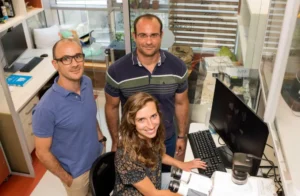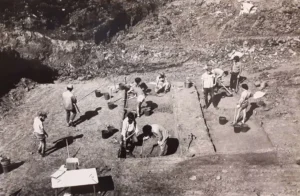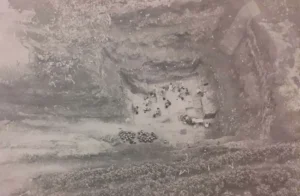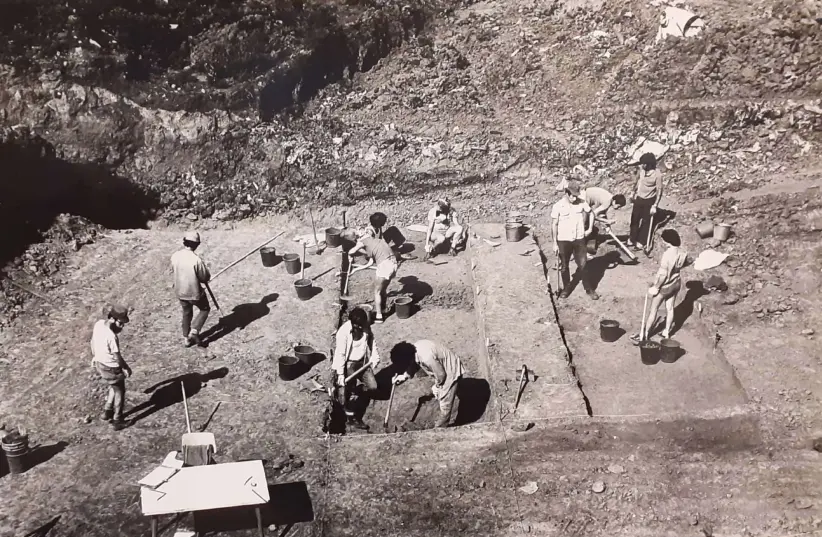A team of Israeli scientists say they have uncovered traces of fire dating back at least 800,000 years.

One brisk winter evening, the young clan mother tucked her children under a pile of bear skins far from the wind blowing in through the cave opening and knocked two pieces of flint rock together on the cave floor, trying to distract the youngsters from the cold. Then the two pieces made a spark, and then another, and a twig next to the rocks caught fire, and soon there was a warm blaze glowing, and her children were warm and happy and sleeping.
Well, maybe.
Of course, there is no way of knowing how or who or when humans learned to make, use and control fire. Until now, it has even been difficult to find any evidence of fire in the very early Paleolithic remains left by ancient hominins, firstly because of the dearth of such sites – perhaps five in all the world – and also because organic remains of fire such as ash and charcoal degrade over time, so there is nothing left to be analyzed.
But now a multidisciplinary team of scientists from the Weizmann Institute of Science in Rehovot say they have uncovered traces of fire dating back at least 800,000 years – one of the earliest known pieces of evidence for the use of fire – using an advanced and innovative method they developed.
Their findings were published June 13 in the peer-reviewed journal Proceedings of the National Academy of Sciences (PNAS).
The scientists believe their AI deep-learning method of data analysis may provide a push toward a more scientific, data-driven type of archaeology. But perhaps, more importantly, it could help provide a better understanding of the origins of the human story.

(L-R) Dr. Filipe Natalio, Dr. Ido Azuri and Zane Stepka (credit: WEIZMANN INSTITUTE OF SCIENCE)
(L-R) Dr. Filipe Natalio, Dr. Ido Azuri and Zane Stepka (credit: WEIZMANN INSTITUTE OF SCIENCE)
“Fire is one of those things that makes humans who they are compared to other animals,” lead writer and archaeology PhD student Zane Stepka said. “We depend on it today. The question of when hominins first started with fire, what was it like taking a burning stick and using it, remains a mystery. It is so difficult [to fathom] what those ancestors were like, yet [they were] so similar to us.”
“Anything we get to understand how they did things in their daily life is very exciting. There was a time our ancestors didn’t have this fire, and then they had it, and it was something magical. We can appreciate how one night they were cold, and then suddenly they have fire and are warm.”
The controlled use of fire by ancient hominin – a group that includes humans and other extinct early human ancestors – is thought to date back at least a million years to around the time that archaeologists believe Homo habilis began its transition to Homo erectus.
Archaeologists believe that fire was instrumental in human evolution, not only for allowing hominins to stay warm, create advanced tools and ward off predators, but also for acquiring the ability to cook. Cooking meat not only eliminates pathogens that cause disease, it increases efficient protein digestion and nutritional value, paving the way for the growth of the brain, the Weizmann Institute said in a press release.
The fire revolution
STILL, THERE is a lack of actual data on when the fire revolution began. Finding archaeological evidence of pyrotechnology primarily relies on visual identification of changes in mainly the color of burnt objects. Traditional data analysis methods have managed to find evidence of fire use going back only 200,000 years.
The researchers said there was some evidence of fire dating back 500,000 years, but it remains sparse, with only five archaeological sites around the world providing reliable evidence of ancient fire.
Dr. Filipe Natalio from Weizmann’s Plant and Environmental Sciences Department and Dr. Ido Azuri from Weizmann’s Life Core Facilities Department had previously collaborated on another project, and their joint work provided the basis for the new AI data-analysis project.
In addition to Stepka, other team members included Dr. Liora Kolska Horwitz from the Hebrew University of Jerusalem and Prof. Michael Chazan from the University of Toronto.
Together, they developed an innovative application of AI and spectroscopy in archaeology to find indications of controlled burning of stone tools dating back between 200,000 and 420,000 years in Qesem Cave in Israel. Their data from last year was used as a point of verification for the recent research.
The researchers applied their AI analysis method on stone tools made of flint, which had been excavated in the Western Galilee’s Evron Quarry in the mid-1970s. During a series of excavations that took place at that time and were led by Prof. Avraham Ronen, archaeologists dug down 14 meters and uncovered a large array of animal fossils and Paleolithic tools dating back to between 800,000 and one million years ago, making it one of the oldest sites in Israel.

None of the finds from the site or the soil where they were found had any visual evidence of heat. Ash and charcoal degrade over time, eliminating the chances of finding visual evidence of burning.
Based on Natalio’s previous work with flint, which determined the stone undergoes irreversible molecular change when heated, the researchers used Raman UV spectroscopy to analyze microscopic samples to reveal that change, helping them to detect if the stones had been exposed to fire use.
But because the molecular components vary from one flint sample to another, the changes caused by heat are too complex in their variability to be measured by traditional data-analysis methods, so it was not so simple, Stepka said. That is when AI deep learning came into play to help decipher those complexities.
AI can find hidden patterns across a multitude of scales. By pinpointing the chemical composition of materials down to the molecular level, the output of the model can estimate the temperature to which the stone tools were heated, ultimately providing information about past human behaviors.
“We tested a variety of methods, among them traditional data-analysis methods, machine-learning modeling and more advanced deep-learning models,” Azuri, who headed the development of the models, was quoted as saying. “The deep-learning models that prevailed had a specific architecture that outperformed the others and successfully gave us the confidence we needed to further use this tool in an archaeological context having no visual signs of fire use.”
USING THIS deep-learning model, the team measured molecular signals from the stone tools used by the inhabitants of the Evron Quarry almost a million years ago, assessing the heat exposure of 26 flint tools found at the site.
The results revealed that the tools had been heated to a wide range of temperatures – some exceeding 600°C. In addition, using a different spectroscopic technique, they analyzed 87 animal bone remains and discovered that the tusk of an extinct elephant also exhibited structural changes resulting from heating. The scientists cautiously suggested that this might indicate that ancient hominins were also experimenting with heat and fire using different materials.
The multidisciplinary approach to their research was key to its success, Natalio was quoted as saying.
“By working together, we have learned from each other. For me, it’s a demonstration of how scientific research across the humanities and science should work,” he said.
Many modern analysis techniques developed until now have been based on looking at sediment for data, Stepka said, adding that this new method allows scientists to work on the stone tools themselves. Thus they were able to analyze stone tools found decades ago in the quarry that no longer exists today, she said.
“With this method, we can test for fire use looking at stone tools, which is something that is preserved in these early sites,” she added. “This is the beauty of it. In places where nothing else is preserved, where there are no other signs of fire, we can look at stone tools made of flint themselves. This opens a lot of opportunities.”
The method was tested using only flint stone tools, so it may not necessarily be effective on other types of stone tools, such as those used in Africa made from quartzite or basalt, Stepka said.
In addition, the evidence of fire use in the Evron Quarry flint tools does not necessarily mean it was intentionally made, and the fire could just as easily have been from a wild fire, she said.
“Now, we have million-year-old artifacts that we know were burnt, and that is something,” Stepka said. “There are theories, but no archaeological evidence of how fire was first made. That is something beautiful in archaeology. There will always be uncertainty. There is always the ‘maybe.’ It keeps us humble and open.”

